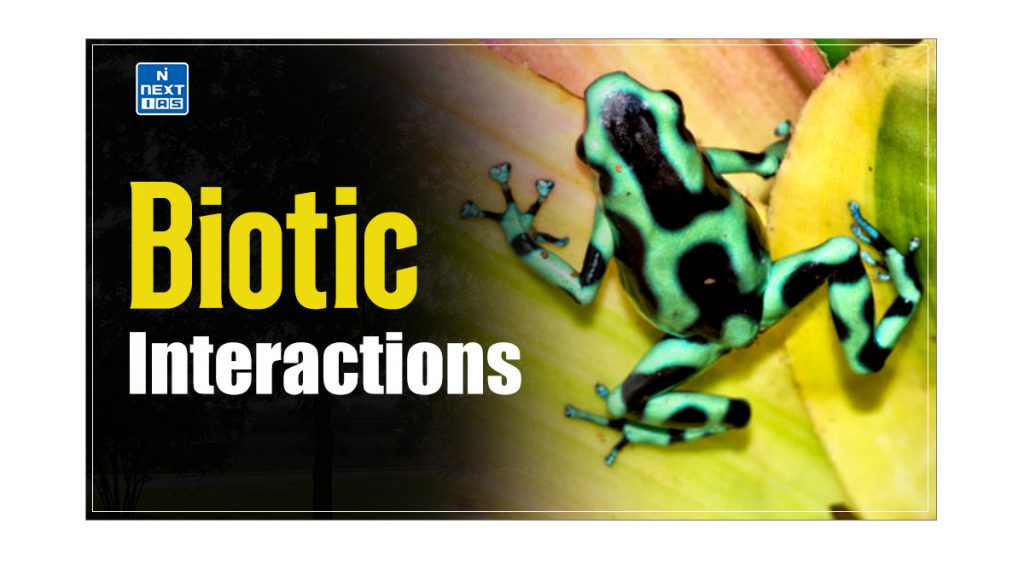
Biotic Interactions form the threads that bind organisms together. These interactions, which occur between living organisms, play a crucial role in shaping ecosystems and influencing the survival, growth, and behaviour of species. This article aims to study in detail the concept of Biotic Interactions, its meaning, and various types such as Commensalism, Mutualism, Predation, Parasitism, Competition, etc.
What is Biotic Interaction?
- Biotic interactions refer to the various ways in which living organisms interact with each other within an ecosystem.
- These interactions can influence the survival, growth, and behaviour of the organisms involved and play a pivotal role in shaping the structure and dynamics of ecosystems.
- Based on the types of organisms involved in the interactions, biotic interactions can be of two categories:
Intraspecific Interaction
The interaction that takes place among different individuals of the same species is called intraspecific interaction.
Interspecific Interaction
The interaction that takes place among individuals of different species in a community is termed interspecific interaction.
Types of Biotic Interactions
Based on the nature of interactions and their effects on the species involved, there are 3 types of biotic interactions:
- Positive Interactions
- Commensalism
- Mutualism
- Symbiosis
- Neutral Interactions
- Neutralism
- Negative Interactions
- Amensalism
- Predation
- Parasitism
- Competition
Each of them is explained in detail in the sections that follow.
Commensalism
- Commensalism is a type of interaction wherein one of the species benefits while the other is neither harmed nor benefited.
- For example, sucker fish remora often attaches to a shark by means of its sucker, which is present on the top side of its head.
- This helps the remora get protection, a free ride, as well as a meal from the leftovers of the shark’s meal.
Mutualism
Mutualism refers to close association between two species wherein both species benefit.
For example, honey bees and flowers are in a mutual relationship, where honey bees benefit through collecting nectar and for the flower, the bees help in pollination.
Symbiosis
- Symbiosis is a type of Mutualism wherein the interaction between the species involved is so intimate that the interacting species cannot live without each other.
- Thus, Symbiosis involves close association.
- For example, corals and zooxanthellae are in a mutual relationship.
Neutralism
- Neutralism refers to the type of relationship between two species that do interact but do not affect each other.
- In this case, the fitness of one species has absolutely no effect whatsoever on that of another.
- For Example: interaction between a dandelion and rainbow trout in a mountain valley or cacti and tarantulas living in the desert.
Amensalism
- This is a negative association between two species in which one species harms or restricts the other species without itself being adversely affected or harmed by the other species.
- For Example: Juglone secreted from the roots of black walnut destroying its surrounding plants and development of wheat hindered by Convolvulus arvensis.
Predation
- In this type of interaction predator captures, kills and eats an animal of another species called the prey.
- The predator naturally benefits from this relationship; while the prey is harmed.
- For Example, owls hunt mice, and shrews hunt worms and insects.
Parasitism
- In this type of interaction, one species is harmed and the other benefits.
- Parasitism involves parasite usually a small size organism living in or on another living species called the host from which the parasite gets its nourishment and often shelter.
- The parasite benefits, but the host is harmed.
- Roundworms, tapeworms, malarial parasites, and many bacteria, fungi, and viruses are common human parasites.
Competition
- This is an interaction between two populations in which both species are harmed to some extent.
- Competition takes place when two populations or species both need the same essential resource that is in short supply.
- For Example, plants compete with each other for soil nutrients, sunlight exposure, temperature, humidity, pollinators, and growing space.
- Depending on the types of species involved, the Competition can be of two types:
Interspecific Competition
Interspecific Competition refers to the competition between different species inhabiting the same ecological area.
Intraspecific Competition
Intraspecific Competition refers to the form of competition between members of the same species inhabiting the same ecological area.
Differences between Interspecific Competition and Intraspecific Competition
| Interspecific Competition | Intraspecific Competition |
|---|---|
| Competition between different species inhabiting the same ecological area. | Competition between members of the same species. |
| Competition is between members of different species. | Competition is between the members of the same species. |
| Occurs between individuals with different adaptations. | Occurs between individuals with similar adaptations. |
| Occurs for a specific requirement. | Occurs for all types of requirements of the species. |
| Either both or one species can be suppressed due to the competition. | Directly affects the population size and composition. |
| Effect is not much severe. | Effect is much more severe. |
Effects of Biotic Interactions
- Different types of Biotic Interactions have different effects on the species involved in interactions.
- The effects of different types of interactions are listed in the table below.
| Type of Biotic Interaction | Species 1 | Species 2 | Effects of Biotic Interaction |
|---|---|---|---|
| Positive Interactions | |||
| Mutualism | + | + | Interaction is favourable to both species. |
| Commensalism | + | 0 | One species (the commensal) benefits, while the other species (the host) is neither harmed nor inhibited. |
| Neutral Interactions | |||
| Neutralism | 0 | 0 | Both species remain unaffected. |
| Negative Interactions | |||
| Parasitism | + | – | Beneficial to one species (parasite) and harmful to the other species (host). |
| Predation | + | – | Predator-prey relationship: one species (predator) benefits while the second species (prey) is harmed and inhibited. |
| Amensalism | – | 0 | One species is inhibited, while the other species is unaffected. |
| Competition | – | – | Adversely affects both species. |
| + means Beneficial; – means Harmful; 0 means Unaffected or Neutral | |||
Antibiosis
- This refers to the full or partial suppression or death of one organism by another, caused by the production of certain substances or environmental conditions resulting from metabolic processes.
- In this case, none of them derives any benefit.
- These substances and/or conditions are harmful to other organisms.
- The phenomenon of antibiosis is more common in the microbial world.
- For Example: Pond blooms of blue-green algae, especially microcystis, produce toxins such as hydroxylamine, which causes the death of fish and cattle.
Conclusion
In conclusion, Biotic Interactions form the foundation of life on Earth. They create dynamic relationships that shape ecosystems and drive evolution. By appreciating the complexity and interdependence of these interactions, we can better understand and protect our planet’s biodiversity.
Frquently Asked Questions (FAQs)
Why are biotic interactions important?
Biotic interactions are very important for proper functioning of ecosystems as they shape the diversity, structure, and function of communities.
What are some examples of biotic interactions?
Some common example of biotic interactions are – pollination, lichen, tapeworm in humans, etc.
What is biotic?
Biotic refers to all living organisms and their products.






